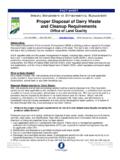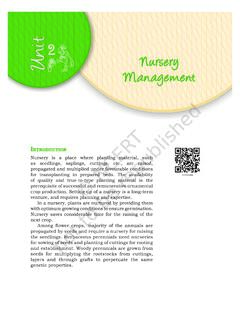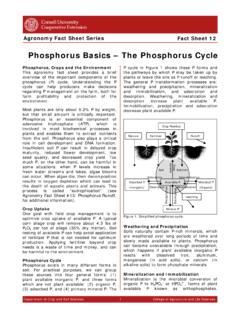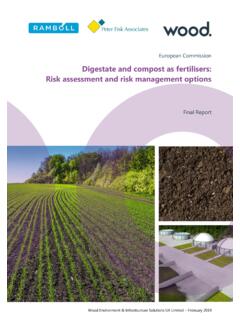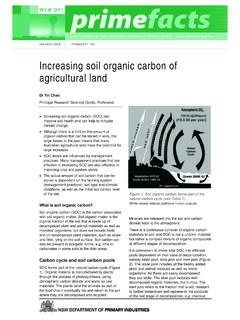Transcription of FactSheet
1 Contact with liquid hydrogen sulfide causesfrostbite. If clothing becomes wet with theliquid, avoid ignition sources, remove theclothing and isolate it in a safe area to allowthe liquid to effects of H2S exposure hydrogen sulfide is both an irritant and achemical asphyxiant with effects on bothoxygen utilization and the central health effects can vary dependingon the level and duration of exposure can result in health effectsoccurring at levels that were previously toler-ated without any concentrations irritate the eyes, nose,throat and respiratory system ( , burning/tearing of eyes, cough, shortness of breath).Asthmatics may experience breathing difficul-ties. The effects can be delayed for severalhours, or sometimes several days, whenworking in low-level concentrations. Repeatedor prolonged exposures may cause eyeinflammation, headache, fatigue, irritability,insomnia, digestive disturbances and weightloss.
2 Moderate concentrations can cause moresevere eye and respiratory irritation (includingcoughing, difficulty breathing, accumulationof fluid in the lungs), headache, dizziness,nausea, vomiting, staggering and properties of H2S gas hydrogen sulfide is heavier than air and maytravel along the ground. It collects in low-lyingand enclosed, poorly-ventilated areas such asbasements, manholes, sewer lines, under-ground telephone vaults and manure work within confined spaces, use appro-priate procedures for identifying hazards,monitoring and entering confined primary route of exposure is inhalationand the gas is rapidly absorbed by the through the skin is can smell the rotten egg odor ofhydrogen sulfide at low concentrations in , with continuous low-level expo-sure, or at high concentrations, a personloses his/her ability to smell the gas eventhough it is still present (olfactory fatigue).
3 This can happen very rapidly and at highconcentrations, the ability to smell the gascan be lost instantaneously. Therefore, DONOT rely on your sense of smell to indicatethe continuing presence of hydrogen sulfideor to warn of hazardous addition, hydrogen sulfide is a highly flam-mable gas and gas/air mixtures can be explo-sive. It may travel to sources of ignition andflash back. If ignited, the gas burns to pro-duce toxic vapors and gases, such as sulfurdioxide. FactSheetHydrogen sulfide (H2S) hydrogen sulfide is a colorless, flammable, extremely hazardous gas with a rot-ten egg smell. Some common names for the gas include sewer gas, stink damp,swamp gas and manure gas. It occurs naturally in crude petroleum, natural gas,and hot springs. In addition, hydrogen sulfide is produced by bacterial break-down of organic materials and human and animal wastes ( , sewage).
4 Industrial activities that can produce the gas include petroleum/natural gasdrilling and refining, wastewater treatment, coke ovens, tanneries, and kraftpaper mills. hydrogen sulfide can also exist as a liquid compressed is one in a series of informational fact sheets highlighting OSHA programs, policies or standards. It does not impose any new compliance requirements. For a comprehensive list of compliance requirements of OSHA standards or regulations, refer to Title 29 of the Code of FederalRegulations. This information will be made available to sensory impaired individuals upon voice phone is (202) 693-1999; teletypewriter (TTY) number: (877) Department of (800) 321-OSHAFor more complete information:DSG 10/2005 High concentrations can cause shock, convul-sions, inability to breathe, extremely rapidunconsciousness, coma and death.
5 Effectscan occur within a few breaths, and possiblya single against H2S exposure Before entering areas where hydrogen sul-fide may be present:1. Air must be tested for the presence andconcentration of hydrogen sulfide by aqualified person using air monitoringequipment, such as hydrogen sulfidedetector tubes or a multi-gas meter thatdetects the should also determine if fire/explosion precautions are If the gas is present, the space/area mustbe ventilated continually to remove If the gas cannot be removed, the personentering the space/area must use appro-priate respiratory protection and anyother necessary personal protectiveequipment, rescue and s Confined Spaces standard con-tains specific requirements for identifying,monitoring and entering confined dangerous H2S atmospheresA level of H2S gas at or above 100 ppm isImmediately Dangerous to Life and Health(IDLH).
6 Entry into IDLH atmospheres can onlybe made using: 1) a full facepiece pressuredemand self-contained breathing apparatus(SCBA) with a minimum service life of thirtyminutes, or 2) a combination full facepiecepressure demand supplied-air respirator withan auxiliary self-contained air supply. If H2S levels are below 100 ppm, an air-puri-fying respirator may be used, assuming thefilter cartridge/canister is appropriate forhydrogen sulfide . A full facepiece respiratorwill prevent eye air concentrations are elevated, eye irrita-tion may become a serious issue. If a half-mask respirator is used, tight fitting gogglesmust also be in areas containing hydrogen sulfidemust be monitored for signs of overexpo-sure. NEVER attempt a rescue in an area that maycontain hydrogen sulfide without usingappropriate respiratory protection and with-out being trained to perform such a rescue.










